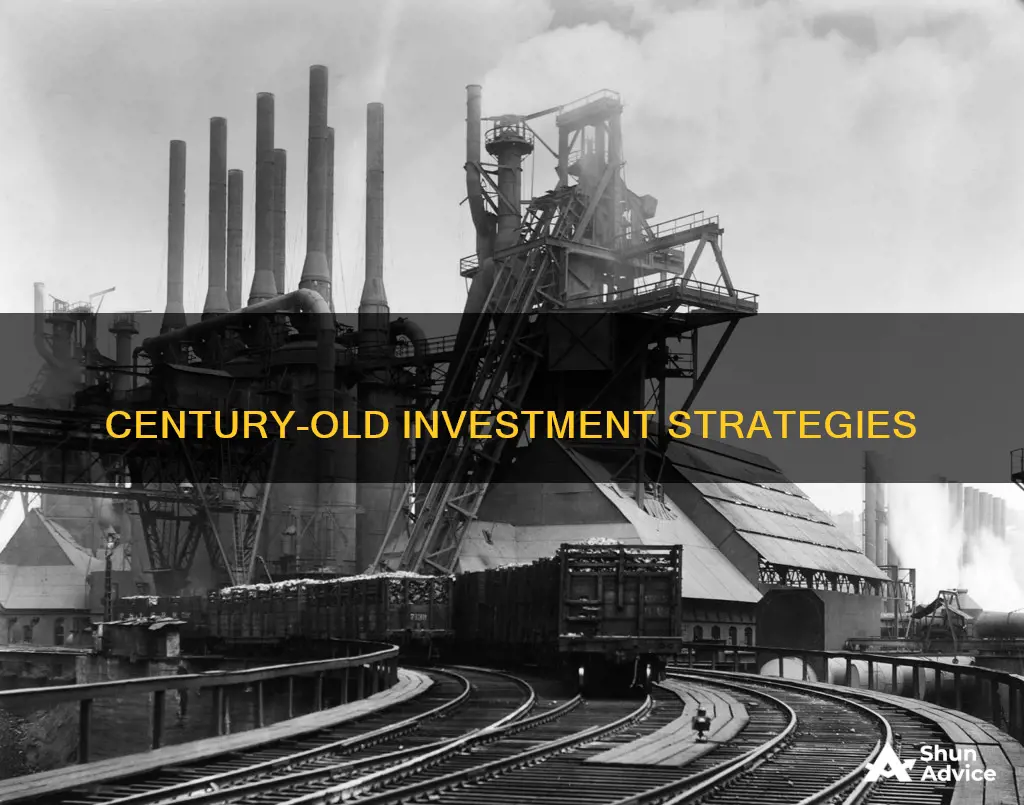
During the 19th century, the financial centre of the US shifted to privately owned, state-chartered financial firms on Wall Street. The number of companies listed on the New York Stock Exchange grew, and there was significant trading by brokers in stocks off the exchange. The invention of the telegraph, the development of railroads, the discovery of gold and other precious minerals, and the arrival of Jewish and Irish immigrants all influenced the Wall Street financial institutions. The most prominent industries of the time included textiles, iron, coal, and steel, as well as railroads, which dominated the US stock market at the beginning of the 20th century.
| Characteristics | Values |
|---|---|
| Investment options | Limited options such as depositing savings in banks, investing in corporate bonds, owning precious metals, and investing in real estate or the stock market |
| Bank deposits | Carried a high risk of loss due to periodic bank failures and no deposit insurance |
| Corporate bonds | Lack of regulation led to a significant risk of default |
| Precious metals | Expensive to store and secure, did not generate investment income, and were less liquid |
| Real estate | Likely the most common investment, but lacked liquidity and stable returns |
| Stock market | Speculative and prone to manipulation, with limited securities regulation |
| Global stock markets | Less integrated, with changes in one market taking days or weeks to impact others |
| US stock market | Dominated by railroads, with over 80% of firm value tied to industries that have since shrunk or disappeared |
| Innovations | Telegraph, development of railroads, discovery of gold and other precious minerals |
What You'll Learn
- People deposited savings in banks, earning fixed interest rates
- Investors could buy corporate bonds, but there was a high risk of default
- The most common investment was real estate, though it was illiquid
- The stock market was an option, but it was a high-risk investment
- Investors could buy gold and silver coins, nuggets, or bars

People deposited savings in banks, earning fixed interest rates
During the 19th century, people could deposit their savings in banks and earn a fixed interest rate on their balance. This was one of the easiest methods of investing excess cash. However, depositing money in banks was risky as there was no deposit insurance, and banks went through periodic cycles of failure where depositors would partially bear the losses.
The interest rates offered by banks were influenced by various economic, social, and political factors. In the 19th century, international trade expanded, and gold-backed currencies were established. Interest rates played a crucial role in regulating the money supply and controlling inflation. Central banks, such as the Bank of England, which was established in 1694, set interest rates and controlled the money supply to stabilize the economy and facilitate investment in new industries.
While depositing savings in banks was a common practice, there were also other investment options available during the 19th century. People could invest in corporate bonds, particularly in the railroad and utility sectors. However, these bond issues were largely unregulated, and there was a significant risk of default. Additionally, government bonds were not yet widely available, as the US Treasury started issuing them in 1917 to fund World War I.
The 19th century also saw the growth of stock markets, especially in countries like Britain and the United States. The New York Stock Exchange, founded in 1817, provided an investment avenue for those seeking higher returns than what banks offered. However, stock ownership was likely not widespread among most savers due to the speculative nature of the market and the lack of securities regulation.
In summary, depositing savings in banks and earning fixed interest rates was a common practice during the 19th century, but it existed alongside other investment options like corporate and government bonds, and the emerging stock markets.
Forging Checks: A Risky Investment Gamble
You may want to see also

Investors could buy corporate bonds, but there was a high risk of default
In the 19th century, investors seeking higher returns than those offered by banks could invest in corporate bonds, predominantly in railroad and utility companies. However, this option carried a high risk of default due to the lack of regulation in bond issues. During the railroad crisis of 1873–1875, for instance, 36% of all US corporate bonds defaulted.
The 19th century witnessed a period of economic growth and transformation, particularly with the emergence of railroads and the expansion of finance and other industries. This era, known as Free Trade (1800-1914), was characterised by the absence of major European wars, allowing for capital accumulation and investment in railroads, finance, and other burgeoning sectors.
During this time, investors seeking to allocate their capital had limited options compared to today's diverse investment landscape. While depositing money in banks was an option, it carried the risk of losses during periodic bank failures, and the FDIC, which insures bank deposits, was not established until 1933.
As a result, investors turned to alternative avenues, including corporate bonds. The lack of regulation in the bond market, however, meant that these investments carried a significant risk of default. This was particularly evident during the railroad crisis, where the default rate was exceptionally high, causing substantial financial losses.
It is worth noting that the 19th century also saw the emergence of stock markets in major countries worldwide. However, investing in stocks was likely a riskier endeavour compared to other options, and stock ownership was probably not widespread among the general population.
Dogecoin: Worthy Investment or Just a Meme?
You may want to see also

The most common investment was real estate, though it was illiquid
In the 19th century, the most common investment was real estate. During the first few centuries of the United States' history, much of the country's wealth was tied up in real estate, whether it was productive agricultural property or homes and buildings that could produce rental income.
However, unlike cash in the bank, real estate was not particularly liquid, and returns were likely subject to the volatility of economic cycles. This probably meant that real estate income was not particularly consistent or stable.
The 19th century saw significant westward settlement and expansion onto Indigenous land. The invention of the telegraph, the development of railroads, and the discovery of gold and other precious minerals in the West, particularly during the California Gold Rush of 1849, all contributed to the growth of real estate investment opportunities. The expansion of transportation networks, such as the completion of the Erie Canal and the rise of railroads, facilitated the settlement of new towns and the development of the West.
The settlement of the West and the growth of new towns led to an increased demand for housing and commercial properties, providing investment opportunities in real estate. The California Gold Rush attracted people from all over, including Jewish and Irish immigrants, further contributing to the demand for real estate in the region.
While real estate was the most common investment, it is important to note that it was not a very liquid asset at the time. Investors had to consider the inconsistent and unstable nature of returns due to economic cycles.
Cramer's Investing Club: Strategies and Secrets
You may want to see also

The stock market was an option, but it was a high-risk investment
The stock market was an option for investors in the 19th century, but it was a high-risk investment compared to other options like real estate or gold. The New York Stock Exchange (NYSE) was founded in 1817, and by the early 20th century, it had been operating for almost 100 years. Despite this long history, investing in stocks was still considered speculative and risky. Securities regulation was minimal, and stock market price manipulation was easier than it is today. Securities trading was also prone to panics and crashes during this period.
The 19th century was a time of growth and transformation for the stock market, particularly in the United States. The NYSE grew significantly during this period due to the expansion of railroads and the need for financing to build them. The invention of the electrical telegraph also played a crucial role in the development of the stock market, allowing for faster communication and more efficient trading. This period saw the rise of influential financial institutions and investors, such as August Belmont and the Seligmans, who played a significant role in financing railroads and mining industries.
However, investing in the stock market was not a common practice among most savers. Other investments, such as real estate, gold, and bank deposits, were considered safer options. Real estate, in particular, was a common investment during this time, as much of the country's wealth was tied up in agricultural property or rental income-generating homes and buildings. Gold and other precious metals were also popular investments, although they were challenging to store and secure.
Bank deposits offered a fixed rate of interest, but they carried a high risk of loss due to periodic bank failures. There was no deposit insurance like we have today, so investors could lose their money if the bank failed. Overall, the stock market presented a higher-risk, higher-reward proposition compared to these other investment options.
In summary, while the stock market was an option for investors in the 19th century, it was a high-risk choice due to limited regulation, price volatility, and the speculative nature of the market at the time. Other investments, such as real estate, gold, and bank deposits, were considered safer and more stable options for most people.
AI-Assisted Investing: The Future of Finance
You may want to see also

Investors could buy gold and silver coins, nuggets, or bars
In the 19th century, investors could buy gold and silver coins, nuggets, or bars. This was a common investment strategy at the time, as precious metals were seen as a stable and secure way to store wealth.
Gold and silver had a long history as a medium of exchange, dating back to ancient times. During the 19th century, the value of a country's currency was often tied to the amount of gold or silver it held in its treasury – this was known as the gold standard or bimetallic standard. This meant that gold and silver were highly valued and considered a safe investment.
The 19th century also saw a growing global market for trade and exchange, fuelled by technological and industrial advancements. Silver, in particular, was an important tool for international trade, especially in Asian markets where it was highly desired. This was advantageous for Western nations, as they could use their silver to purchase Asian gold, which was more expensive for them.
However, investing in gold and silver came with certain challenges. Precious metals were expensive to store and secure, and they did not generate any investment income. As a result, investors in the 19th century may have viewed gold and silver more as a medium of exchange rather than purely as an investment.
Investments: Are They for Everyone?
You may want to see also







